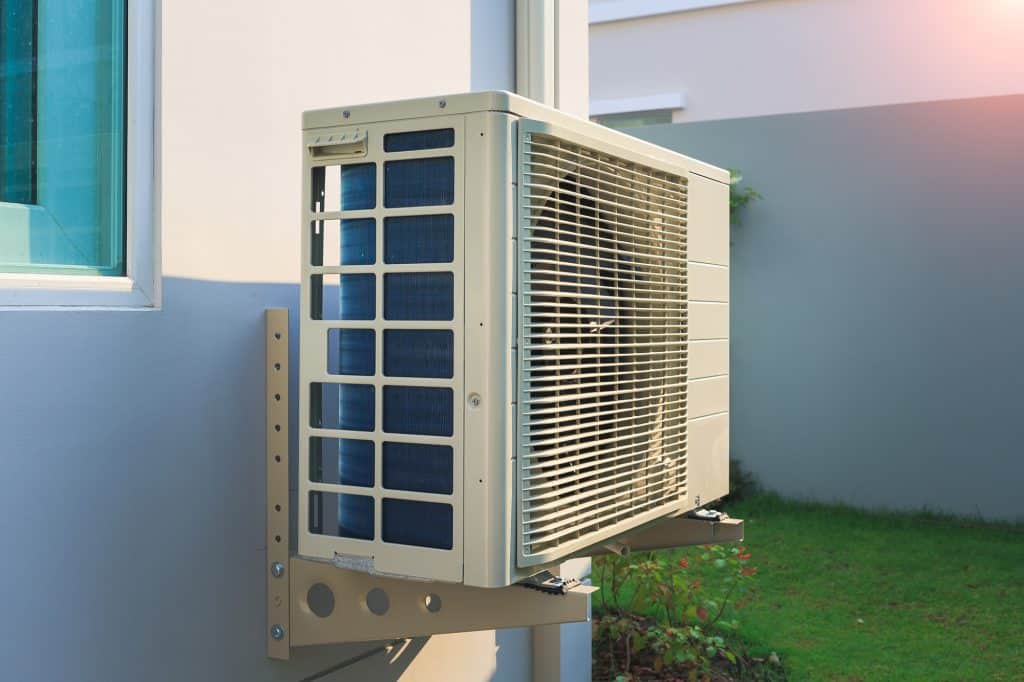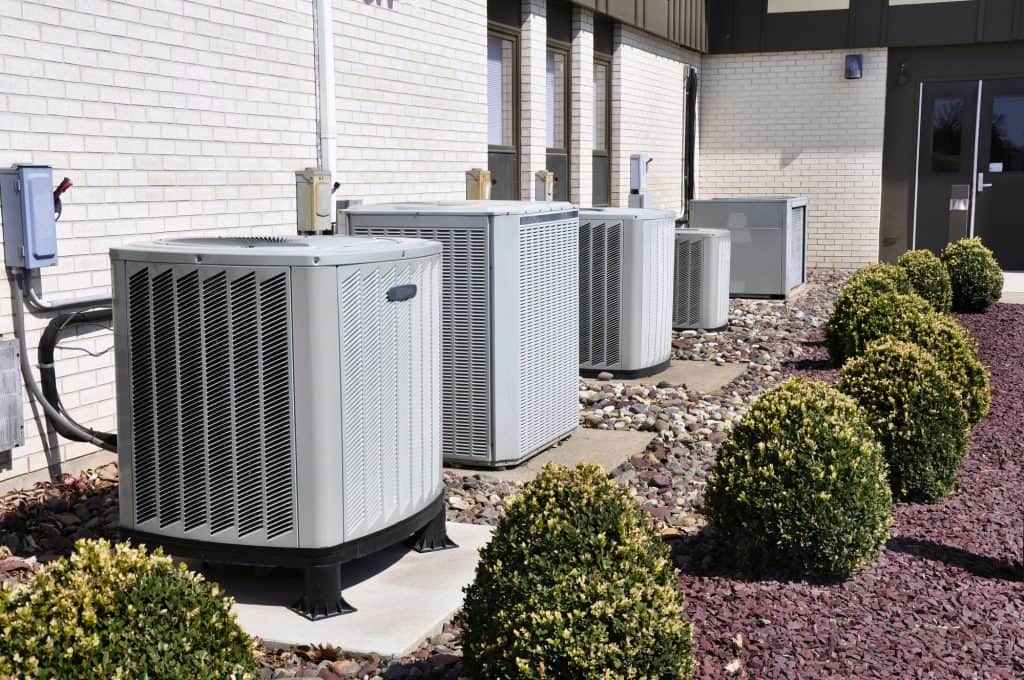If you are in a position where either your indoor or outdoor AC unit needs replacing, you may be interested in whether the tonnage of the two units should match. Installing a smaller unit may be cheaper, but will it work? Can the tonnage of the indoor and outdoor units be different?
Indoor and outdoor should be matched to work together efficiently. Indoor and outdoor AC units with different tonnage should not be used together. The initial costs may be lower, but the system will not cool efficiently and may cost you more electricity or damage to the units.
Many homeowners are aware that an AC unit consists of two components, an indoor unit, and an outdoor unit. This may tempt homeowners to replace one or the other with a different tonnage unit to save costs. Despite the initial savings, we will discuss why this is not a good idea.
What Is Tonnage In AC Units?

Understanding the tonnage of indoor and outdoor AC units is beneficial to understand why a system should be matched.
The unit of measure used to express the effectiveness or power of an AC unit is the British Thermal Unit or BTU. This BTU rating is established by determining that it will take 288000 BTUs of energy to melt 2000 pounds of ice in a 24-hour period. This equates to 12000 BTUs per hour.
Since 2000 pounds is a ton, a 12000 BTU Ac unit is a 1-ton AC unit. This is essentially a measure of the cooling capacity of the AC units. A 1.5-ton unit will be able to cool a space down faster than a 1-ton Ac unit.
How To Find The Tonnage Of Your AC Units
Tonnage is a common capacity descriptor used in North America to describe the cooling capacity of AC units. However, the common unit for the rest of the world is BTU.
Consequently, your AC unit may not have the tonnage specified on the unit’s label or in the user manual unless it was made in the USA or made specifically for the USA market.
Fortunately, now that we have told you that 12000 BTU is the equivalent of a 1-ton AC unit, you can easily calculate the tonnage. Divide the specified BTUs of your AC unit by 12000 to obtain the tonnage.
If you have an 18000 BTU AC unit, it is a 1.5-ton AC unit. If the unit is a 24000 BTU AC, then it is a 2-ton unit, and so on and so forth.
So how does this influence whether you can use mismatched tonnage units for your indoor and outdoor units?
Can You Mix Different Tonnage Indoor And Outdoor AC Units?

Now that we have discussed what is meant by the tonnage of an AC unit, the reason they should not be mismatched will become clear.
We have two main possibilities when considering mixing indoor and outdoor AC unit tonnage. These are:
- Mixing a higher tonnage outdoor unit with a lower tonnage indoor unit.
- Mixing a lower tonnage outdoor unit with a higher tonnage indoor unit.
Can A 2 Ton Outdoor Unit Be Installed With A 1.5 Ton Indoor Unit?
In this scenario, we have a larger capacity outdoor unit paired with a lower capacity indoor AC unit. A logical examination of this situation will help determine if this is a good idea or not.
A 2-ton AC outdoor unit will be extracting heat from a large volume of air, dropping the temperature significantly, and then pushing this large volume to the indoor AC for distribution into the home.
If the indoor AC unit is a 1.5-ton capacity unit, it will have difficulty in keeping up with pushing out the larger volume of air from the outdoor unit.
This can cause several problems in the AC units.
- The indoor unit fans will struggle. The fans on the indoor AC unit are designed to handle a specific throughput and may become overwhelmed by the output from the outdoor unit.
- Icing up of the indoor unit. The high volume of cold air coming through the indoor unit will cause it to ice up if it cannot disperse the cold air fast enough.
- Liquid coolant can be returned to the compressor. If the refrigerant in the coils has not returned to gaseous form and returned to the compressor in this state, it can cause the compressor to malfunction.
- The SEER rating of the AC will be affected. The SEER rating is how much energy you can expect the AC unit to consume. This will affect your electricity utility bill since mismatched units can consume more electricity.
When the indoor and outdoor units are paired in this configuration, the AC may work initially, but it will be inefficient, and the smaller unit will be working much harder than it should. This increases wear on the indoor unit and reduces its usable life.
In other cases, the inability of the indoor unit to keep up may cause damage to the outdoor compressor unit, resulting in further repair or replacement costs.
If the mismatch is too great and the indoor unit is significantly lower-powered compared to the outdoor unit, the combination may not work at all.
As a result, while the initial cost saving may be tempting to install the AC units with this type of tonnage mismatch, it will reduce the overall life of both AC units in the long run.
Can You Install A 2.5 Ton Indoor Unit With A 1.5 Ton Outdoor Unit AC?

In this installation scenario, the outdoor AC unit is a lower capacity than the indoor AC unit. How will this installation play out, and would it be viable?
Considering our previous scenario where the indoor unit was too small to cope with the output from the compressor, you may think that a larger indoor AC unit would be able to handle a smaller outdoor unit.
It is not a case of the indoor unit taking all the outdoor unit can dish out, but rather the overall efficiency of units that were designed to work in tandem.
The lower-powered outdoor unit may not be able to deliver sufficient airflow to allow the indoor unit to function correctly.
The consistently high demand from the indoor unit can cause the outdoor unit coils to freeze over, particularly when the aircon is on high in hot weather. This is the time when you need the aircon the most, and it may cease to function.
While this installation scenario will be less damaging to the two inits, it will nonetheless still be inefficient, and the units will not work as well as expected.
Some installers will fit this type of mismatched aircon pair and adjust refrigerant pressures and levels to compensate for the difference in power. However, most certified AC installers will not be a party to this installation scenario since there will be issues with the equipment down the line, and the installer will get the blame.
This will tarnish an installer’s reputation, and most installers are not willing to risk their name in the marketplace to accommodate a homeowner who wants to cut corners and costs.
What Are The Issues With Mixing Air Con Tonnages?

Besides the inefficiencies and risk of failure of AC units when the tonnage is mismatched, there are several other reasons why installers are reluctant to agree to these installations.
- Refrigerant incompatibilities. AC units with different power ratings may use different refrigerants to achieve their cooling volume. This can raise refrigerant incompatibilities between indoor and outdoor units, causing problems with pipes and valves.
- Electronics incompatibilities. The electronics and associated connectors in one unit may not be compatible with the electronics in the other unit.
- Higher installation cost. The labor needed to effectively “jimmy” the two systems to work may be significantly more expensive.
- Void warranties. If either of the AV units is under warranty, installing mismatched tonnage units can void any applicable.
- Nullified insurance claims. Any insurance claims for damage to the AC system can be nullified if the insurance assessor discovers a mismatched, non-standard installation.
Most AC units are designed to work efficiently and safely with the supplier’s recommended pairings. Going outside of these standards may result in less than desirable results and could end up costing more money sooner than you expected.
Conclusion
While installing indoor and outdoor AC units with mismatched tons may be possible, it is not a recommended solution. Invariably, if there are no problems immediately after the installation, the likelihood of further problems in the short term is high.
If you have a cash flow problem preventing you from a complete new install, speak to your HVAC installer and ask if they have any reconditioned units available at a lower cost. This may be a less than ideal solution since you have no knowledge of the history of the secondhand unit, but it is a better solution than a mismatched system.
